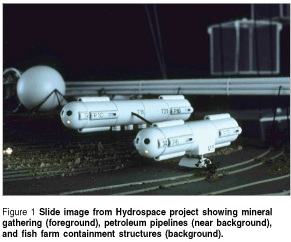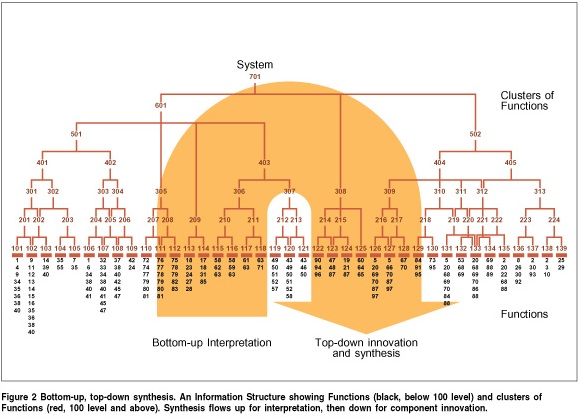For those who think about design and innovation, a relatively exotic argument has been going on for a while. The issue is about how best to structure the overall innovation process. Do you look first for the grand concept and then derive details for a full system solution? Or do you first seek individual insights about proposed system functions, environments and users, and then integrate ideas to an overall grand concept? In essence, should the creative process be one of deduction or induction?
Background
The argument was brought to the fore for me in a 1969 symposium that accompanied an exhibit and celebration of the 50th anniversary of the Bauhaus. The Bauhaus, in its heyday, was the European school at the center of the modern design movement. Because Illinois Institute of Technology housed the two most viable schools tracing lineage to the Bauhaus, it was the primary American site for the anniversary celebration. IIT’s Institute of Design was founded by Laszlo Moholy-Nagy, former Director of the Bauhaus’ famed Preliminary Course and its Metal Workshop. He came to Chicago in 1937 to start the New Bauhaus, which became the Institute of Design in 1944 and, in 1949, a school of IIT. Also at IIT, was Mies van der Rohe’s School of Architecture. Mies, who was the Bauhaus’ last Director (before Hitler closed the school), came to IIT in 1938 to take over its architecture program. Both design and architecture schools were located in S. R. Crown Hall, one of Mies’ most famous buildings, an ideal location for a Bauhaus retrospective.
The symposium was intellectually stimulating as expected, but for me, the most interesting ideas came from an argument that arose over the way innovation is structured. A little background will help:
In the spirit of German architects and architectural educators of the 30’s, Mies was a stern task master with a firm belief in first principles. “Architects do not design, they build”. Architecture was taught at IIT with great concern for craft, materials and established details of form and construction perfected by Mies in his teaching and practice in Germany and then in Chicago. Mies’ approach to architecture was top-down. His concepts had been worked out and perfected in whole and detail, and only then applied in variation – designs tailored to the requirements of specific sites.
The Institute of design’s philosophy followed a more experimental approach espoused by Moholy. Moholy was an artist, designer and photographer with a whole-systems’ curiosity about form, function and the processes to create and fulfill them. He taught design as an exploratory process, welcoming new approaches, technologies and perceptions. His was basically a bottom-up approach.
Although Moholy had died decades earlier and Mies had left IIT a decade before the symposium (and died a month before its opening), the two approaches to planning, design and innovation continued strongly in both schools. For me, as a young Assistant Professor and graduate of the Institute of Design, the experimental, exploratory approach was natural and had already led me to computers – just then becoming available – and Christopher Alexander’s novel method of modeling design problems as graphs or networks that could be analyzed by computer. “Alexander’s Method” was basically a bottom-up approach. I had worked with it and my own modifications to it for four years, culminating at the time of the symposium in a systems design project, Hydrospace, that explored future uses of the oceans.
Although he was not at the symposium, Alexander’s work was known internationally (in architectural circles, he was recognized as a revolutionary thinker). Much less widely known, my work was familiar, at least locally, to many attendees of the symposium. With Mies’ thinking deeply felt, the debate about top-down vs bottom-up thinking became an undercurrent issue for speakers as well as attendees. Historical contradictions at the Bauhaus reinforced continuing contemporary confrontations! And the debate continues.
Top-down
Top-down innovation, while not always recognized as such by name, is what most people do when they are actively trying to solve problems creatively. This is the “Eureka” model in its natural form. Basically, the innovator looks at all the relevant information, during which the creative process is allowed to incubate with the goal of an epiphany that, in one clear concept, will solve the problem.
Books on creativity contain scores of examples. One of the more widely known is the story of the discovery of the structure of benzene. Benzene was known to be a hydrocarbon, but a structural configuration for it using any of the linear models then understood didn’t fit its known composition. Friedrich August Kekule, who had been working on the problem for several years, found himself one evening staring into a fireplace “day dreaming”. As he watched the flames, he imagined chains of molecular “snakes” dancing before him (he had long used images of dancing molecules to help visualize atomic arrangements). Amidst these images, he saw a fiery molecular snake grasp and eat its tail – and in a flash of recognition, saw the analogy between the closed loop and a ring – hexagonal ring configuration that would successfully explain the composition of benzene.
An example from my own experience concerns a project on the future of prefabricated housing. I had spent months investigating its history from the 1700’s forward. At the beginning of my research, I was certain that the problem was about better concepts for structure. As my work progressed, my efforts showed me that, in fact, there were hundreds of good and novel structural concepts, most never realized commercially! Nevertheless, it was clear also that the need for a better approach to industrialized housing was real, but what approach? Probably not another structural system!
For weeks I continued to ask myself, “what IS the problem?” Finally it dawned on me that the essence of the problem was electro-mechanical systems and utilities – not structure! A quick check suggested that the current cost of a house was almost half consumed by the cost of the electrical, mechanical and utility products and systems installed, an increase from the late 1800’s that followed a power curve. I was able to substantiate this insight with research that showed – by almost any measure – I was right. The problem to be solved was how to integrate these new systems effectively with housing design and building processes.
Given the overarching concept – integrated structural, utility and electro-mechanical systems – the rest of the design project was, if not easy, at least clear-cut: a top-down application of a master concept to the details necessary to complete the design.
The key to top-down innovation is having an overarching concept before working out details. Sometimes it can be the product of years of development, resulting in a set of extensive, integrated principles as demonstrated by Mies van der Rohe’s approach to architecture – or Frank Lloyd Wright’s or Frank Gehry’s. Sometimes it may be the product of intense investigation with a focus on finding the essence of a problem and a clear concept for application. The important distinction between top-down and bottom-up is where in the process the search for essence is satisfied. For top-down, it is early, before the crystallization of details.
Bottom Up
The innovator working from the bottom up confronts a problem as parts before the whole. This approach is natural for complex problems and, usually, any problem worth treating as a system. The trick is having some kind of model of the problem/s to work against. If you are going to innovate piece by piece, you have to know all, most, or at least the key topics to work on before you start.
The Hydrospace project mentioned above is a good example of bottom-up innovation. The project began with a charter from the ARMCO Steel Company to explore futures for ocean industries. Preliminary research suggested that the project should consider deep-sea oil production, harvesting minerals from the sea bottom, and high-value fin fish farming. These activities would be organized loosely into a system, with service support as a fourth major component.
The next step was to gather information on these topics, which design teams did over a period of months. Research results were distilled into what were termed Problem Elements succinctly pinpointing key information about problems experienced or anticipated in the areas of concern. As each Problem Element was documented, ideas for what to do about it were included – beginning the bottom-up idea generation process. Over one hundred Problem Elements ultimately were recorded and organized by computer into a hierarchical Information Structure that provided a more detailed model to innovate against.
Teams then were reorganized to match the understanding presented by the Information Structure. The organizing principle used to create the structure had put Problem Elements together that were likely to have solutions in common, or at least have design implications for each other (see my article: Organizing for Innovation). While the underlying structure of the original model (petroleum, minerals, fish farming, etc.) remained fundamental, problems that had been identified in one area had found their way (sometimes surprisingly) across boundaries into others, making the new structure more richly sophisticated.
Working upward from the bottom clusters of most closely related Problem Elements, the teams progressively modified, combined, expanded and refined ideas toward a total system solution. At the end, the “grand concept” addressed a wide range of problems with an integrated, multi-component solution. Figure 1, from a slide presentation, shows some of the system’s components.
Bottom-up innovation sacrifices the clarity and simplicity of an early, over-arching concept for (usually) a more complex concept that draws upon many insights attained from problems addressed across the project. The essence of the solution, if it can be simplified enough to be expressed as such, comes at the end of the synthesis process when concepts for components have been finally blended into a full system solution.
How About Both?
As the tools of Structured Planning have evolved, experiments have explored the advantages and disadvantages of top-down and bottom-up approaches. Even at the time of the Bauhaus symposium, it seemed clear that a combination of both could be better than either alone.
The strength of the top-down approach is the simplicity and clarity of vision that it can bring. Like Occam’s razor for science, the simplest solution is frequently the best for design. The weakness of this approach is that it can force aspects of a solution into a mold without regard for special characteristics that might dictate otherwise.
The strength of the bottom-up approach is the thoroughness of exploration it forces and the creative freedom it encourages throughout the development process. Its weakness is the uncertainty of its vision. In the end, there may be elegance in complexity – or just simply complexity.
In recent years, a composite approach has been used in Structured Planning (see Figure 2). An Information Structure is created following generally the process outlined above, but using “Functions” as its elements (see my article: Covering User Needs). Once the Functions have been organized into an Information Structure, Synthesis teams work bottom-up to find meaning and names for the nodes, striving to find titles that at once capture an insightful categorical description of the functionality below and share the degree of abstraction of sibling nodes at the same level.
Click image to view Figure 2
When the structure has been named, a top-down process is engaged to invent the final System Elements. At nodes chosen high enough in the structure to cover 10-20 Functions, teams use an “Ends/Means Synthesis” process (to be described in an upcoming article) to conceive component System Elements that will cover the needs of the Functions below. Available to the teams from earlier work are preliminary ideas (Solution Elements) and insights (Design Factors) about what goes wrong (or right) as Functions are performed. My articles Insight and Ideas and Capturing Ideas discuss these innovation tools.
The result is a two-stage process that enlists the thoroughness of the bottom-up process to define a structured master plan, then launches top-down innovation across the structure to give form to elements of the system.



















